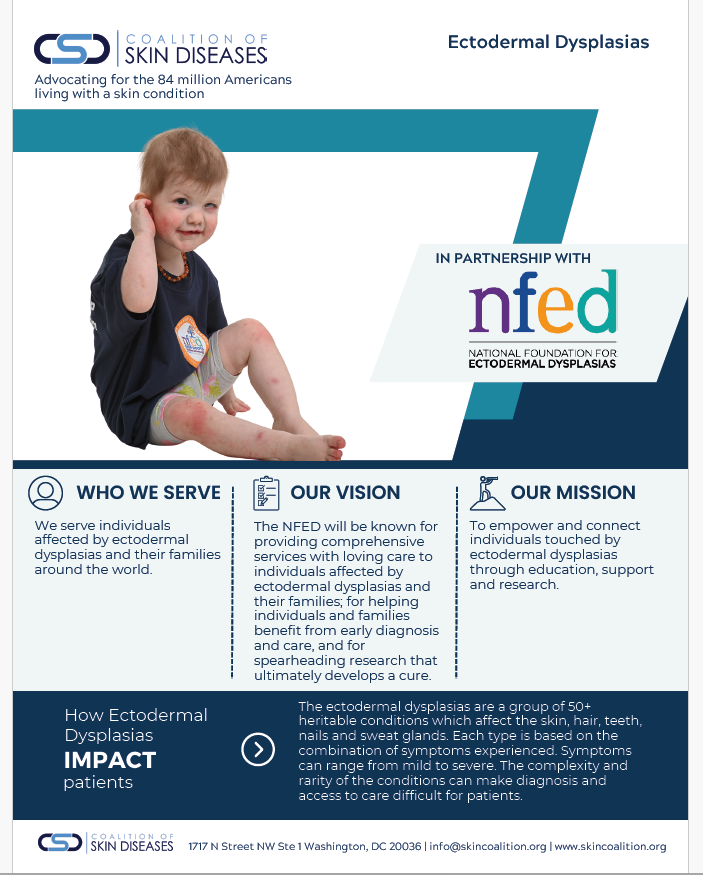Ectodermal dysplasias are a diverse group of genetic disorders that involve defects of the hair, nails, teeth, glands and skin. Other parts of the body may be affected also. The combination of physical features a person has and the way(s) in which it is inherited determines if it is an ectodermal dysplasia.
More than 180 different types of ectodermal dysplasias exist. Yet, most types share some common features, with symptoms ranging from mild to severe. The early diagnosis of a specific type will help identify which combination of symptoms the person has or will have.

People are born with ectodermal dysplasia. For some syndromes, signs (i.e. cleft lip and palate, missing fingers, skin erosion) are apparent at birth. For others, symptoms may not become noticeable until the baby grows. For example, a baby born affected by hypohidrotic ectodermal dysplasia, typically has peeling skin at birth. Yet a parent might not realize something is wrong until the baby’s teeth do not develop correctly. Or, the parent might notice the baby is lethargic and irritable when hot but not realize it’s because the sweat glands don’t work correctly.
It depends on the specific type of ectodermal dysplasia a person has. Even within each type, people can be affected differently depending on the combination of symptoms they have. Any one of the abnormalities may be mild or severe. The physical appearance, then, varies from person to person including within a family and family to family.
Several types of skin symptoms typically occur in ectodermal dysplasias. However, these skin conditions and their severity can vary according to the type of ectodermal dysplasia. At birth, the skin symptoms of ectodermal dysplasias could be dry, cracked, pale, thin with prominent blood vessels, lax around the eyes, thick on the palms and soles or peeling. In infants affected by hypohidrotic ectodermal dysplasia (HED), the skin of the hands, feet, and, sometimes the entire body, may have more than the usual redness and peel, revealing normal-looking skin underneath.
Other skin issues include extreme cases of diaper rash and seborrhea. The skin may be dry, scaly and easily irritated. The dryness is primarily caused by genetically defective or absent skin surface proteins that help trap moisture on the skin’s surface. The oil and sweat glands may also be poorly developed or absent. Most people with ectodermal dysplasia do not experience frequent skin infections. However, the skin on the scalp, hands and feet in ankyloblepharon-ectodermal defects-cleft lip and/or palate (AEC) syndrome and ectrodactyly-ectodermal dysplasia-clefting (EEC) syndrome may become red, weepy, crusty and somewhat swollen. In both males and females affected by HED, nipples may be small or absent. Females who are either affected by or are carriers of ectodermal dysplasia may also have underdeveloped breasts or breasts that are very unequal in size.
Hair symptoms for ectodermal dysplasias vary according to the type. The hair on your scalp can show different symptoms than hair on other parts of your body, such as eyebrows, eyelashes and body hair. Hair symptoms can include absent hair, sparse, fine, lightly pigmented, abnormal in texture, fragile, unruly, sticking out in all directions, difficult to comb, and hair that’s dry due to absent or poorly developed oil glands. The eyebrows, eyelashes and other body hair may also be sparse or missing hair. Body hair may thicken and darken at puberty, however, facial hair and hair of the groin and underarms typically develop normally in adolescents with ectodermal dysplasia.
There are also many different nail abnormalities that can occur in association with these conditions. Not all people who are affected by ectodermal dysplasias will have nail abnormalities. However, nail symptoms are fairly common and may include poorly developed, small, thick or thin, brittle, discolored, cracked, abnormally curved, and ridged nails. In addition, they may grow slowly or shed periodically. Other times, the nails develop light spots, lines, or patches.
People with some types of ectodermal dysplasia are not able to sweat normally. Because of this inability to sweat, people with this symptom need to be especially careful in warm or hot environments. The inability to sweat is called hypohidrosis and caused by a decrease in sweat glands.
For more information, visit NFED.org.

Connect with your federal legislators to speak up for dermatological conditions today.